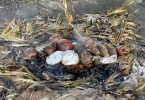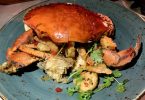After dancing on the Pont d’Avignon, visiting the Roman aqueduct in Pont du Gard and taking a nostalgic trip to the windmill of Daudet, it is time to bid farewell to Provence and the distinct aromas of pines, herbs and lavender. We stop briefly in front of what has become our companion for the day, fields of sunflowers dancing in the sun and capture the memory.

The scenery changes from olive groves and vineyards to that of mountains, sea and bush covered high plains. We join the A9 Autoroute to Narbonne via Montpellier. I spot Camargue, not too distant on the map, a place where the land, the sea and the sky are intermarried. We would like to take the detour but the autoroute is a quicker alternative to our destination for the night, Toulouse.
We enter Languedoc, a region of mountains and coastlines, located between the Massif Central in the north and the Mediterranean, spreading west of Arles towards the Spanish border. The province takes its name from the language of its inhabitants, the langue d’oc as opposed to the langue d’oil practised in the north; both prevalent between the ninth and fourteenth centuries.
Gastronomically, the region prides itself on rustic cuisine and its proximity to Spain adds a Catalan flavour influenced by the Romans and the Moors who occupied the region. Regional specialities include saucisson de Toulouse, a pink skinned garlic known as le rose d’Albi, foie gras, confit de canard and confit d’oie. Roquefort is also at home in Languedoc, a sheep’s milk cheese that is aged in the caves of Roquefort-sur-Soulzon.
If there is one dish that symbolises Languedoc, it is undoubtedly the earthy cassoulet. Taking its name from Cassol d’Issel, the earthenware pot used to cook it, it is said to have originated in the town of Issel near Caustelnaudray. But this humble dried white bean dish boasts as many variations as the bouillabaisse. Some insist it must include confit d’oie, others declare it should only contain beans, pork and sausages, omitting tomatoes and breadcrumbs. In any case, most agree on one thing. This is country fare that is best enjoyed with a young, full-bodied red.
About 40% of France’s wine is made in Languedoc but very few regional ones are of premium quality. There are reds from the Pays Catalan such as Collioure and Cotes de Roussillon, some of the best include those from l’Hérault, Corbières and sweet and fortified wines such as Banyuls from Roussillon and Muscat de Rivesaltes.

We have a long way to drive this afternoon to reach Toulouse. Mr G is at the wheel and is keen on arriving before sunset. On the autoroute, the maximum legal speed is 130 km/hour but many drivers exceed 190 km/hour then slow down to pay a toll at each péage.
We soon realise that there is nothing to see along the autoroute but multi-laned tollways kept in perfect condition. The towns are too distant and the possibility of passing a village with an old chateau or pretty vineyards is remote.
Autoroutes have aires along the way, resting areas set back from the road, providing fresh water, amenities and occasionally food outlets. Some are designated by numbers but are often referred to by name. Some are given directional names such as A1, autoroute du nord and A4 autoroute de l’est. Others are given more creative names such as, A10 l’Aquitaine, A11 l’océane, A8 la provençale, and my favourite, A6 l’autoroute du soleil. In contrast, Route Nationales have parking spaces where motorists can stop for a rest and offer a scenic alternative.
We are driving along A9, la languedocienne, which clings to the coast from Montpellier to the Spanish border. I spot views of vines stretching away from the coast. At Narbonne, we join the A61 to take us to Toulouse. What follows is a non-stop drive with Mr G negotiating trucks, slow cars and the occasional car flying at 200 km/hr. Pretending to be Alain Prost in our Renault 19, he reaches speeds of 170 km/hr with ease while I close my eyes and scream in silence.
Signs indicating the number of kilometres to various towns remind us of the proximity to Spain. How tempting it would be to get to Barcelona, if we had an extra day. Alas, we continue flying through Languedoc until we spot a fairy tale pink town.

Carcassonne, a double-walled, fortified town with towers and turrets was once the most important European medieval fortress and played an important role in Languedoc’s efforts to remain independent of northern France until 1209. The history and sights including the Chateau Comtal fortress overlooking the south side of the Cite and the adjacent Basilique Saint-Nazaire are of interest to us but we settle for a brief stop at an aire panoramique to see the pink fortress town from afar.
… continues tomorrow
‘Le Tour de France Gourmantic’ series is the story of a young couple from Australia who took to the French roads on a whirlwind Tour of France back when the internet wasn’t at everyone’s fingertips, phones were still attached to sockets, GPS was an unfamiliar acronym, digital cameras were a pipe dream and the Euro hadn’t replaced French Francs. With just one fold-out map of France and boundless enthusiasm, they took their Renault 19 and went on a cultural and culinary discovery.






[…] This post was mentioned on Twitter by Ms Gourmantic, Ms Gourmantic. Ms Gourmantic said: New on G: Flying through Languedoc in a Renault 19 http://bit.ly/c7LOBn Le #tdf continues through Languedoc #france #travel […]